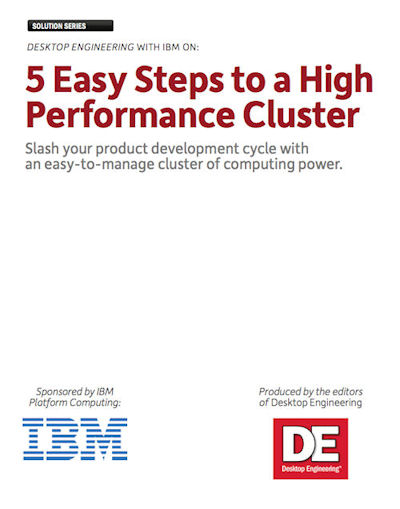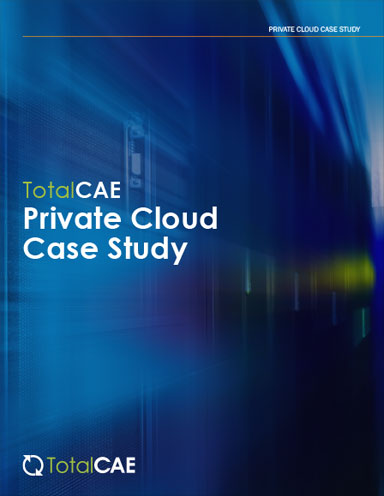Check it Out: 5 Easy Steps to a High Performance Cluster
Latest News
September 5, 2013
 |
As a Desktop Engineering subscriber, you may have taken part in a survey about your familiarity with high performance cluster computing and its benefits. Some of the survey results are fascinating.
For example, while 88% of respondents report they use compute- and data-intensive CAE (computer-aided engineering) and visualization applications, just 18% of respondents say they are familiar with the benefits of HPC (high performance computing). Another 48% say that they are aware of HPC clusters but do not consider themselves very knowledgeable about them, and 33% report that they are unaware or not familiar with the HPC cluster concept.
No matter where your familiarity with HPC clusters resides, you will gain a greater awareness of what they are and what they can mean for your engineering organization from today’s white paper, “5 Easy Steps to a High Performance Cluster.” This 15-page PDF was sponsored by IBM Platform Computing and produced by my editorial colleagues at Desktop Engineering without my input (insert pouty whine). Although his Poobah here was not involved in the production of this paper, he admits that it is a well done, easy to read, and informative document. BTW, you’ll find a link to the survey results in this paper.
The title points you to a step-by-step guide for implementing an HPC cluster successfully. It’s at the end right immediately before the paper’s appendix, which contains a good glossary of HPC lingo and links to further resources. The guide is first-rate stuff, especially if you’re just now developing an HPC cluster implementation plan. Still, because more than 80% of you report little or no knowledge of HPC clusters, what may be this document’s greatest immediate strength for you is everything leading up to the implementation guide.
The paper begins at square one by defining what a cluster is and why it’s important for engineering—productivity, higher-quality results, and faster time to market, among the many reasons. It briefly explores the basic hardware, such as multicore servers and interconnect technologies, then segues into cluster management software, the secret sauce of HPC cluster technology.
Cluster management software provides the means for identifying, monitoring, and managing your hardware and software. You have two choices here: open source or commercially developed and supported. The paper comes down on the side of commercially developed software, using the IBM Platform Computing family of integrated cluster management tools to illustrate its reasoning.
Why? Open source software drags along all sorts of complexity, ranging from discrete tools with different user interfaces to informal user-based support to end user and IT unfriendliness. Open source may be a tinkerer’s dream, but not a reliable or productive use of IT’s time, expertise, or budget.
The paper backs up its assertions about the benefits of commercially developed cluster management software with real-world user testimonials, dollar figures, charts, and links to additional information. Topics covered include workload management, job scheduling, parallel applications, third-party integrations, professional support, and ease of everything like deployment, maintenance, end user experience, required IT skills, and scaling.
All of that makes a compelling case but, at its heart, the argument concerns your total cost of ownership (TCO). And it is this argument that is the most compelling from both the CFO’s and the IT manager’s point of view. One example: the TCO of a self-assembled cluster management software system is 35% more than a commercial version, says the paper. Again, the paper backs that up with a linked TCO calculator that can help you estimate a figure for yourself.
“5 Easy Steps to a High Performance Cluster” debunks many CFO-type budgetary objections as well as the IT manager’s doubts about the skills to deploy, manage, and configure an HPC cluster. (FYI: there’s a link to a on-demand webinar on setting up an HPC cluster in 24 hours.) It demonstrates that free software not only has expenses that can add up fast but that it does not offer the extensions, services, ease of use, and functionality of a dedicated commercial system.
The DIY crowd may get a little squirmy reading this paper, but forget about that. We’re talking mission critical technology here. You owe it to yourself to learn more about HPC clusters and cluster management software technology and their potential benefit for you. Hit the Check it Out link over there to download your complimentary copy.
Thanks, Pal. – Lockwood
Anthony J. Lockwood
Editor at Large, Desktop Engineering
Subscribe to our FREE magazine, FREE email newsletters or both!
Latest News
About the Author
Anthony J. Lockwood is Digital Engineering’s founding editor. He is now retired. Contact him via [email protected].
Follow DE




